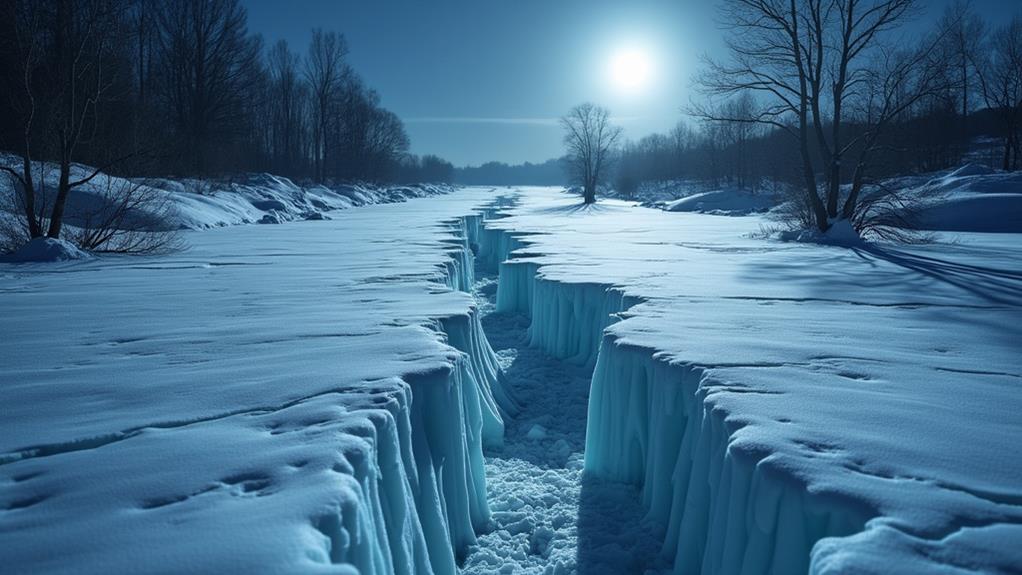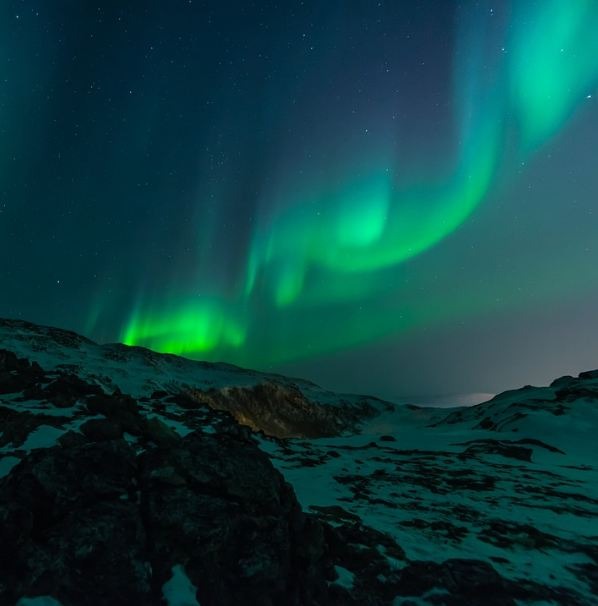Why Do Ice Tsunamis Happen?
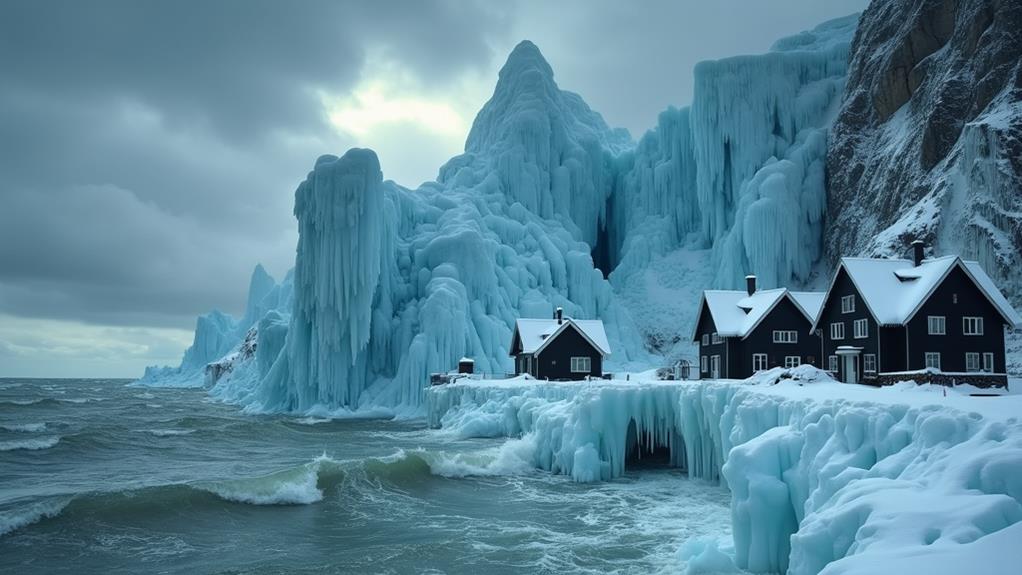
Ice tsunamis, or ice shoves, happen when powerful winds exceeding 60 mph push lake ice onto shorelines, causing massive ice piles. These events are more common in early spring when warming temperatures weaken the ice cover. The wind dynamics, combined with temperature fluctuations, create the perfect conditions for ice to break and shift. Gently sloping shores and fluctuating water levels amplify the movement, leading to significant property damage. Coastal communities, especially around the Great Lakes, are particularly vulnerable. By understanding these factors, you can grasp the potential impacts and underlying causes of ice tsunamis more effectively.
Key Takeaways
- Strong winds exceeding 60 mph push broken ice masses onto shorelines, causing ice tsunamis.
- Rapid temperature fluctuations create stress fractures in ice, facilitating movement during warmer spring months.
- Gently sloping shores enable ice to advance several meters, amplifying ice tsunami effects.
- Wind and water dynamics generate mechanical forces that propel ice sheets across water surfaces, leading to ice shoves.
- Climate change destabilizes ice sheets, increasing the frequency and severity of ice tsunamis in affected regions.
Definition of Ice Tsunamis
Ice tsunamis, also known as ice shoves, are powerful natural events that happen when strong winds push broken lake ice onto shorelines. You might witness these dramatic occurrences in the Great Lakes region, especially during early spring when ice cover begins to weaken. When strong winds blow, they force large chunks of ice inland, creating an overwhelming force capable of causing significant property damage.
Imagine massive blocks of ice moving towards shorelines, piling up to heights of up to 16 feet. These ice shoves can easily overrun structures like lampposts, patios, and even homes. The term "ice tsunami" reflects the dramatic and often destructive nature of these events, although officially, organizations like NOAA define them as on-shore ice pushes caused by wind and currents.
Historical accounts of ice shoves date back to the 1820s, emphasizing their long-standing impact on coastal environments. The Great Lakes region is particularly vulnerable due to its extensive ice cover and frequent strong winds. When these conditions align, the result is a force of nature that reshapes landscapes and can leave costly damage in its wake. Understanding ice shoves helps you better appreciate their power and prepare for their potential impact.
Key Causes of Ice Shoves
Understanding the key causes of ice shoves helps you appreciate the complex interplay of natural forces behind these dramatic events. One vital factor is wind speeds. When winds exceed 60 mph, they can push broken ice masses onto shorelines, creating ice shoves. The sheer force of the wind acts on the ice's surface area, causing significant movement.
Temperature fluctuations also play an important role. As temperatures rapidly cool, ice contracts. Conversely, warming triggers the thermal expansion of ice. These changes create stress fractures, allowing the ice to break and move more easily. This thermal dynamic is fundamental in facilitating the movement of ice toward land.
Additionally, the interaction between wind action and fluctuating water levels generates bending forces that further push the ice. This is particularly impactful on gently sloping shores where the ice can advance several meters beyond the shoreline. On inland lakes, the wind and currents are the dominant forces influencing ice movement, as tidal effects are minimal.
Wind and Water Dynamics
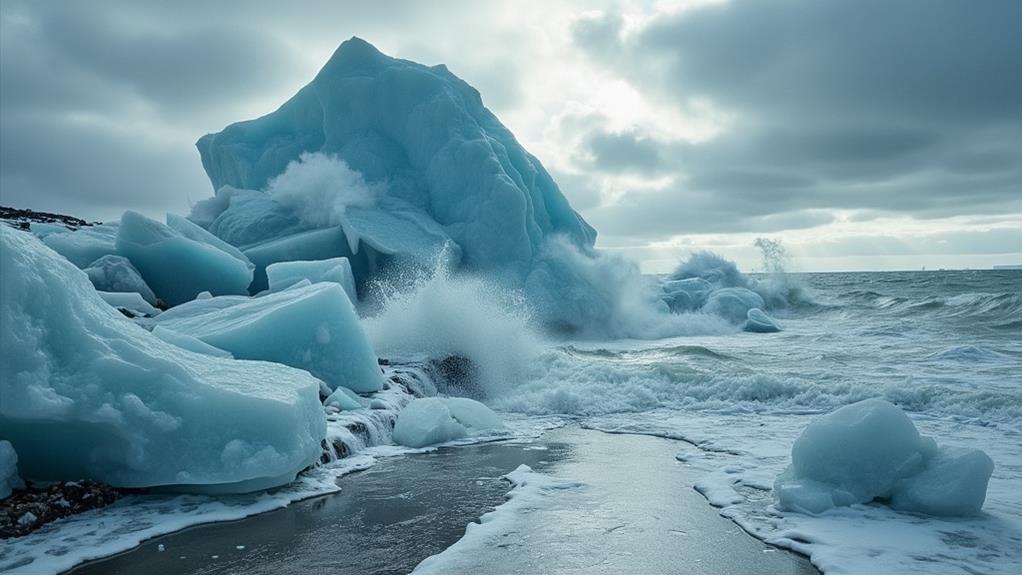
Wind and water dynamics play an essential role in the occurrence of ice tsunamis. When strong winds, gusting over 60 mph, press against loose ice, they generate significant pressure that pushes the ice ashore, creating ice shoves. As the wind interacts with the water, it forms open channels, allowing ice sheets to move more freely. This movement is especially pronounced during early spring when the ice begins to weaken.
Wind action doesn't just push the ice; it also creates mechanical forces that propel ice sheets across the water. The water's surface roughness and currents further influence how far and in which direction the ice will travel. In inland lakes, sustained winds combined with gentle beach slopes make it more likely for ice shoves to occur. Under these ideal conditions, ice can advance several meters beyond the shoreline.
During early spring, the combination of strong winds and fluctuating water levels facilitates the formation and movement of ice shoves. As the ice expands and contracts, the dynamics between wind and water become even more vital, leading to increased ice displacement. Understanding these elements helps explain why and how these dramatic ice tsunamis happen.
Temperature Fluctuations
Temperature fluctuations play an essential role in the formation of ice tsunamis. When temperatures rise and fall, ice expands and contracts, causing stress fractures within the ice sheets. These fractures set the stage for dramatic ice shoves, where large chunks of ice get pushed ashore.
A rapid decrease in temperature can cause significant volume decreases in ice sheets, increasing the likelihood of ice movement toward the shoreline. This thermal expansion requires a completely frozen surface to facilitate movement, as free-floating ice will naturally expand toward areas of least resistance.
Seasonal shifts, especially the warming of spring, create ideal conditions for ice to weaken and become more susceptible to displacement by wind and currents. During these times, the ice is more prone to breaking apart and moving with ease. Historical patterns reveal that ice shoves typically occur in early spring when temperature changes are most pronounced.
These dynamic interactions between ice and water during seasonal shifts are vital. As temperatures fluctuate, the ice's behavior becomes unpredictable, setting the stage for the dramatic events known as ice tsunamis. By understanding these fluctuations, you can better grasp how and why these natural phenomena occur.
Impacts on Coastal Communities
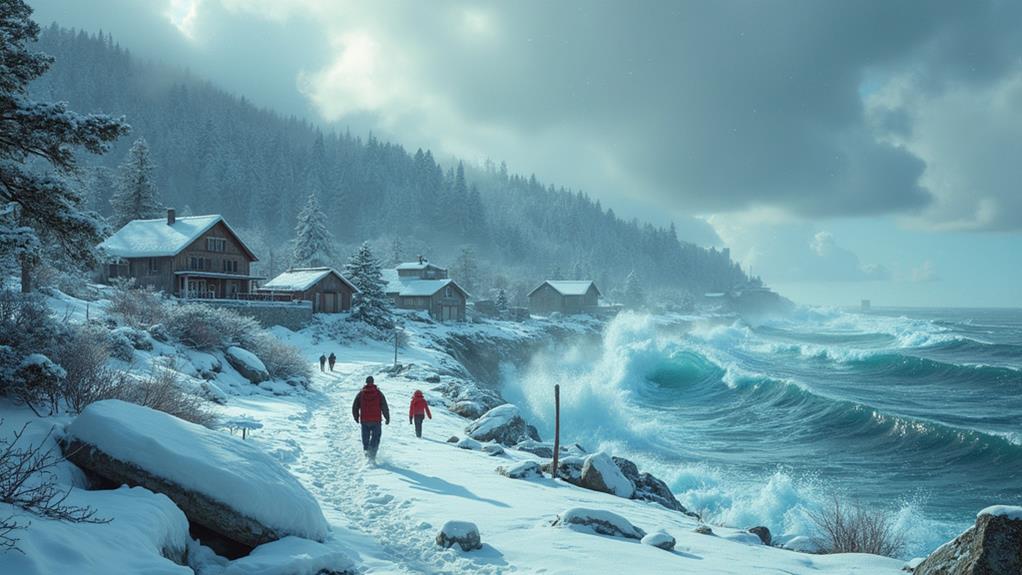
Ice tsunamis, or ice shoves, can wreak havoc on coastal communities by causing extensive damage to buildings and infrastructure. Imagine living along the Chukchi Sea and waking up to find your home surrounded by towering ice piles, sometimes reaching heights of 25 feet. These formidable ice shoves can overwhelm structures like lampposts and patios, leading to costly repairs and even displacing residents.
The damage isn't just limited to buildings. Ice shoves also exacerbate coastal erosion, altering landforms and destroying habitats. This erosion can severely impact local ecosystems and the wildlife that depends on stable shorelines. For coastal communities, these changes are more than just environmental concerns—they threaten livelihoods dependent on natural resources, making daily life even more precarious.
Historical incidents, such as the severe ice shove event in Manitoba in 2013, highlight just how vulnerable coastal communities are to these ice-related disasters. These events underscore the need for better planning and stronger infrastructure to mitigate future risks. Without such measures, the increasing open water days and shifting ice formation patterns will continue to raise the risk of destructive coastal events, making ice shoves a persistent and growing threat to coastal communities.
Climate Change Connections
Understanding how climate change influences the frequency and severity of ice shoves is essential for grasping the full scope of their impact on coastal communities. As global temperatures rise, you'll notice that warmer conditions greatly impact ice dynamics, enhancing the likelihood of ice tsunamis. The destabilization of ice sheets due to rising temperatures and altered weather patterns plays a vital role in amplifying these coastal events.
Projections show that Arctic ice cover may decline dramatically, potentially leading to ice-free summers by 2050. This decrease in landfast ice formation and earlier breakup times increases the risk of destructive ice shoves. When ice that once remained stable starts to move, it can cause severe damage along coastlines.
Additionally, ongoing climate change is expected to modify storm activity and ocean-atmosphere interactions. These changes can further influence mid-latitude regions, making ice shoves more common and intense. The polar vortex, which is becoming more erratic due to climate change, also contributes to shifting weather patterns that escalate the occurrence of ice tsunamis.
Historical Case Studies
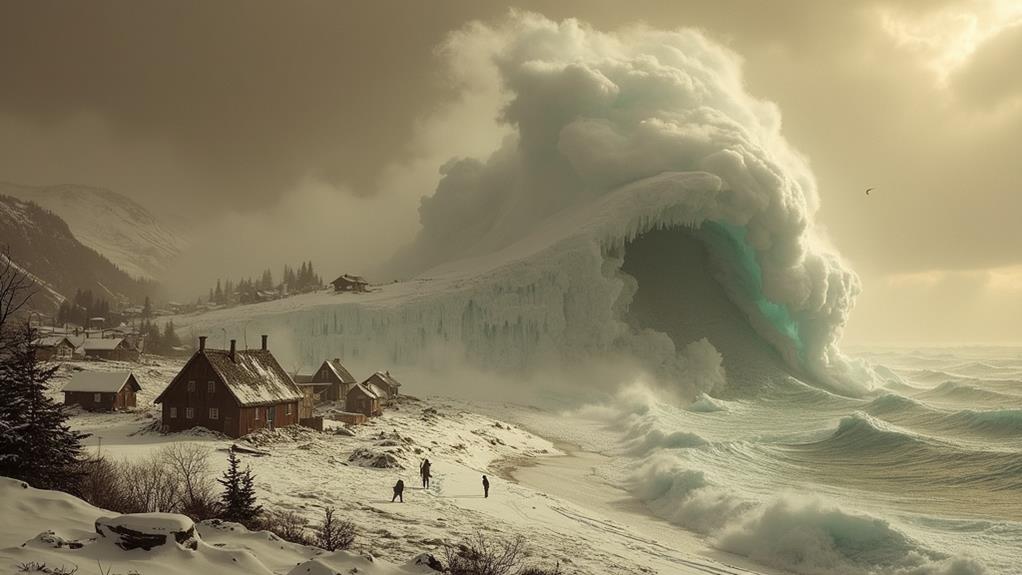
Historical case studies offer significant insights into the destructive force and patterns of ice tsunamis over time. Looking at events like the 2013 ice shove in Manitoba, you can see the extensive damage these phenomena can inflict on homes and communities. Historical records reveal that ice shoves have been observed since 1822, indicating their persistent presence in cold climates.
In the Great Lakes region, such as Mille Lacs Lake in Minnesota, documented ice tsunamis have caused considerable property damage. These incidents underscore the region's vulnerability and the crucial need to understand the sequence of events leading to such destruction. Likewise, Lake Winnebago in Wisconsin has experienced ice shoves that exemplify the localized impact on infrastructure and natural landscapes.
The 2004 study along the Alaskan Chukchi coast sheds light on the spring dynamics of ice shoves in Arctic environments, contributing to a broader understanding of their behavior. By examining these historical case studies, you can grasp the profound impact of ice tsunamis and the importance of studying their patterns to mitigate future damage. Each incident builds a clearer picture of the risks and necessary precautions for communities facing these formidable natural events.
Frequently Asked Questions
What Causes an Ice Tsunami?
You're wondering what causes an ice tsunami. Ice movement dynamics, like strong winds and temperature changes, push broken lake ice ashore. This affects local ecosystems and can have a significant environmental impact. Historical occurrences show that these events often happen in early spring. To prevent damage, communities should monitor conditions and take measures to protect vulnerable areas. Understanding these causes helps manage and mitigate risks effectively.
Can Melting Ice Caps Cause Tsunamis?
Melting ice caps don't directly cause traditional tsunamis. They lead to rising ocean levels due to climate change, which can affect coastal regions. Glacial movements and ice shelf destabilization from ice cap melting can create localized waves, sometimes called 'ice tsunamis.' However, these events are fundamentally different from seismic tsunamis. The primary coastal impacts from melting ice caps are more about rising sea levels and changing weather patterns.

